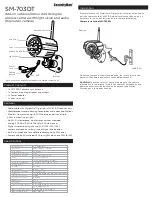
Series Installation Guide
Approved Document No: 26-1197
AF&S
Issue: 1 Authorised: Date: 01/8/2013
Drift Compensation Limit
In the case of the smoke chamber reaching the end of it`s compensation limit, the detector will flash it`s LEDs continuously to signal that the
detector should be replaced. This can be confirmed with the Sensitivity Test Wand.
SPECIFICATION
EN54-5/7 approval
Supply Voltage:
10.5~33V
Alarm Current:
20-24mA at 24 volts
Quiescent Current:
50uA Maximum
Smoke Sensitivity:
0.08 dB/m - 0.12 dB/m
Temperature class:
A2R (for OSCELUS-HR); A2S (for OCELUS-HF)
Humidity Range:
0% to 95% Relative Humidity, non condensing
Maintenance Information
OCELUS detectors are generally installed as part of a fire alarm system.
Servicing of the system should be carried out in accordance with the requirements of the local code of practice for fire alarm installations, eg. BS
5839 Part 1, Fire Detection and Alarm Systems for Buildings: Code of Practice for System Design, Installation and Servicing.
The frequency of inspection testing will be based on a risk assessment of the installation, but should be no more than 6 months between visits.
Over a 12 month period every detector should be functionally tested, using suitable equipment to generate smoke or heat (EG the Solo range from
No Climb Products)
All OCELUS smoke detectors have an IR transmitter that periodically transmits chamber data. This allows the detectors sensor status to be
checked with a Sensitivity Test Wand.
Cleaning
Cleaning a smoke detector can prolong its working life. The detector can be cleaned with:-
A hand held vacuum cleaner
A clean air
line or a “duster” aerosol
A lint free cloth.
The effectiveness of cleaning will depend on the operating environment of the detector. Depending on timescales & financial considerations,
detector cleaning may not be a practical option.
When to replace a detector
A detector should be considered as needing to be replaced if:-
The detector does not respond to a functional test
If the Sensitivity Test Wand reports the chamber as bad
If the detector has had an unexplained activation*
If the detector has been in service for more than 10 years**
* In some cases it may be sensible to leave a detector until a second unexplained activation, but consider the extra service costs and perceived
system integrity if this is done.
** Many detectors will continue to function adequately way beyond 10 years service. Balance the frequency of unwanted alarms, with the cost of
replacing detectors when making this decision.
EN54-5:2000+A1:2002
Heat detectors — Point detectors
EN54-7:2000+A1:2002 + A2: 2006
Smoke detectors — Point detectors using scattered light,
transmitted light or ionization
OCELUS Conventional detectors
200-0010, 200-0011, 200-0012 & 200-0013




















